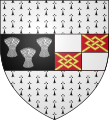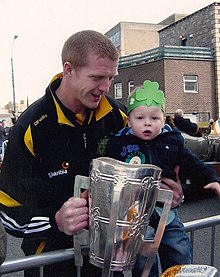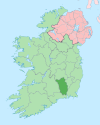Portal:County Kilkenny
The County Kilkenny Portal
County Kilkenny (Irish: Contae Chill Chainnigh) is a county in Ireland. It is in the province of Leinster and is part of the Southern Region. It is named after the city of Kilkenny. Kilkenny County Council is the local authority for the county. At the 2022 census the population of the county was 103,685. The county was based on the historic Gaelic kingdom of Ossory (Osraighe), which was coterminous with the Diocese of Ossory. (Full article...)
Selected articles

Kilkenny (Irish: Cill Chainnigh [ˌciːl̠ʲ ˈxan̠ʲəj], meaning 'church of Cainnech') is a city in County Kilkenny, Ireland. It is located in the South-East Region and in the province of Leinster. It is built on both banks of the River Nore. The 2022 census gave the population of Kilkenny as 27,184, the thirteenth-largest urban center in Ireland.
Kilkenny is a tourist destination, and its environs include historic buildings such as Kilkenny Castle, St Canice's Cathedral and round tower, Rothe House, Shee Alms House, Black Abbey, St. Mary's Cathedral, The Tholsel, St. Francis Abbey, Grace's Castle, and St. John's Priory. Kilkenny is also known for its craft and design workshops, the Watergate Theatre, public gardens and museums. Annual events include Kilkenny Arts Festival, the Cat Laughs comedy festival and music at the Kilkenny Roots Festival.
Kilkenny began with an early 6th-century ecclesiastical foundation within the Kingdom of Ossory. Following the 12th-century Norman invasion of Ireland, Kilkenny Castle and a series of walls were built to protect the burghers of what became a Norman merchant town. William Marshall, Lord of Leinster, gave Kilkenny a charter as a town in 1207. By the late 13th century, Kilkenny was under Hiberno-Norman control. The Statutes of Kilkenny, passed at Kilkenny in 1367, aimed to curb the decline of the Hiberno-Norman Lordship of Ireland. In 1609, King James I of England granted Kilkenny a Royal Charter, giving it the status of a city. Following the Irish Rebellion of 1641, the Irish Catholic Confederation, also known as the "Confederation of Kilkenny", was based in Kilkenny and lasted until the Cromwellian conquest of Ireland in 1649. From 1840 onwards, Kilkenny has not been administered as a city under local government law, but the Local Government Reform Act 2014 provides for "the continued use of the description city". (Full article...)
Selected history articles

Osraige (Old Irish) or Osraighe (Classical Irish), Osraí (Modern Irish), anglicized as Ossory, was a medieval Irish kingdom comprising what is now County Kilkenny and western County Laois, corresponding to the Diocese of Ossory. The home of the Osraige people, it existed from around the first century until the Norman invasion of Ireland in the 12th century. It was ruled by the Dál Birn dynasty, whose medieval descendants assumed the surname Mac Giolla Phádraig.
According to tradition, Osraige was founded by Óengus Osrithe in the 1st century and was originally within the province of Leinster. In the 5th century, the Corcu Loígde of Munster displaced the Dál Birn and brought Osraige under Munster's direct control. The Dál Birn returned to power in the 7th century, though Osraige remained nominally part of Munster until 859, when it achieved formal independence under the powerful king Cerball mac Dúnlainge. Osraige's rulers remained major players in Irish politics for the next three centuries, though they never vied for the High Kingship. In the early 12th century, dynastic infighting fragmented the kingdom, and it was re-adjoined to Leinster. The Normans under Strongbow invaded Ireland beginning in 1169, and most of Osraige collapsed under pressure from Norman leader William Marshal. The northern part of the kingdom, eventually known as Upper Ossory, survived intact under the hereditary lordship until the reign of King Henry VIII of England, when it was formally incorporated as a barony of the same name. (Full article...)
Selected landmarks articles

Rothe House /ˈroʊθ/ is a late 16th-century merchant's townhouse complex located in the city of Kilkenny, Ireland. The complex was built by John Rothe Fitz-Piers between 1594–1610 and is made up of three houses, three enclosed courtyards, and a large reconstructed garden with orchard. As a museum, it is accessible to the public.
Rothe House is the only remaining example of a complete burgage plot in Ireland, and considered to be nationally significant because of the range of original post-medieval features that survive. The property, an important element of Kilkenny's heritage, is owned by the Kilkenny Archaeological Society and houses some of the society's collection of artefacts relating to Kilkenny City, County and Ireland.
The garden to the rear of the house has been reconstructed to reflect a typical 17th-century garden. It features a well dug by Cistercian monks (based in Duiske Abbey in Graiguenamagh) who owned the property before the dissolution of monasteries. The burgage plot on which Rothe House was built survives intact – one of a few in such an unaltered state. Kilkenny's medieval city wall forms part of the curtilage of the Rothe House complex. (Full article...)
Selected geography articles
The barony of Callan (Irish: Callainn, meaning 'Callow land') is a barony in the west of County Kilkenny, Ireland. The barony is 22.9 square kilometres (8.8 sq mi) in size. It is one of 12 baronies in County Kilkenny. Unusually for a barony, it contains only two civil parishes which together comprise 65 townlands. The chief town is Callan. The barony is bordered by the baronies of Shillelogher to the north (whose chief town is Bennettsbridge) and by Kells to the south (whose chief town is Kells). The N76 road bisects the barony. Notable features include Callan Motte and Callan Augustinian Friary. (Full article...)
Ballyhale (Irish: Baile Héil) is a village in the south east of Ireland. Located in the south of County Kilkenny, south of the city of Kilkenny and roughly halfway to Waterford city. (Full article...)
The River Suir (/ʃʊər/ SHOOR; Irish: an tSiúr [ənʲ ˈtʲuːɾˠ] or Abhainn na Siúire [ˌəun̠ʲ n̪ˠə ˈʃuːɾʲə]) is a river in Ireland that flows into the Atlantic Ocean through Waterford after a distance of 185 kilometres (115 mi). The catchment area of the Suir is 3,610 km2. Its long term average flow rate is 76.9 cubic metres per second (m3/s), about twice the flow of either the River Barrow (37.4 m3/s) or the River Nore (42.9 m3/s) before these join, but a little less than the Barrow's flow when it meets the Suir 20 km downstream (over 80 m3/s). (Full article...)

Jenkinstown Park is a park in County Kilkenny, Ireland. It is situated off the N78 road about 10 km north of the city of Kilkenny and 11 km south of Castlecomer. (Full article...)
Selected quotation
"If you ever go to Kilkenny, Remember the Hole in the Wall, You may there get drunk for a penny, Or tipsy for nothing at all."
|
— Unknown, circa 18th Century. |
Selected Did you know

- ... that Kilkenny (pictured) gets its name from Cainnech of Aghaboe?
- ... that the River Nore flows through County Kilkenny and Kilkenny? (Full article...)
Selected slideshow image
Selected biography articles
Constantia Grierson (née Crawley; c. 1705 – 2 December 1732), was an editor, poet, and classical scholar from County Kilkenny, Ireland. She is notable for her achievements as a classicist, which were all the more remarkable given her labouring-class background. (Full article...)
James Stephens (Irish: Séamus Mac Stiofáin; 26 January 1825 – 29 March 1901) was an Irish Republican, and the founding member of an originally unnamed revolutionary organisation in Dublin. This organisation, founded on 17 March 1858, was later to become known as the Irish Republican Brotherhood (I.R.B). (Full article...)
Thomas F. Kilroy (23 September 1934 – 7 December 2023) was an Irish playwright and novelist. (Full article...)
Hubert Marshal Butler (23 October 1900 – 5 January 1991) was an Irish essayist who wrote on a wide range of topics, from local history and archaeology to the political and religious affairs of eastern Europe before and during World War II. He also travelled to Nazi Austria on his own initiative and at his own expense and helped save Jews from being sent to concentration camps. (Full article...)
Selected sport articles
Henry Shefflin (born 11 January 1979) is an Irish hurling manager and former player who is the current manager of the Galway senior hurling team. In his playing career he was nicknamed "King Henry" because of his directive style, dominance, competitive spirit, and leadership on the field. He is the only player to win 'hurler of the year' three times, in 2002, 2006, and 2012. Cian Lynch is the only other player to win the title more than once, winning it in 2018 and 2021. He is widely regarded as the best player in the history of the game. A versatile forward who started out in the corner, Shefflin made his name in more commanding positions as a centre or full-forward. He is widely regarded to be one of the greatest players in the history of the sport, with many former players, commentators and fans rating him as the number one player of all time.
Raised in Ballyhale, County Kilkenny, Shefflin served an obligatory but underrated hurling apprenticeship at St Kieran's College. He joined the Ballyhale Shamrocks senior team as a goalkeeper at the age of 17 in 1996 and spent the next 21 years as one of the club's key outfield players. He is one of only a handful of men to have won the All-Ireland Club Championship as a player and as a manager. Shefflin's association with Kilkenny began as a member of the minor team in 1996. He progressed through the under-21 and intermediate ranks before making his senior debut in 1999. Shefflin brought his 18-season association with the black and amber jersey to an end when he announced his inter-county retirement on 25 March 2015. (Full article...)
Related portals
Associated Wikimedia
The following Wikimedia Foundation sister projects provide more on this subject:
-
Commons
Free media repository -
Wikibooks
Free textbooks and manuals -
Wikidata
Free knowledge base -
Wikinews
Free-content news -
Wikiquote
Collection of quotations -
Wikisource
Free-content library -
Wikiversity
Free learning tools -
Wikivoyage
Free travel guide -
Wiktionary
Dictionary and thesaurus































































